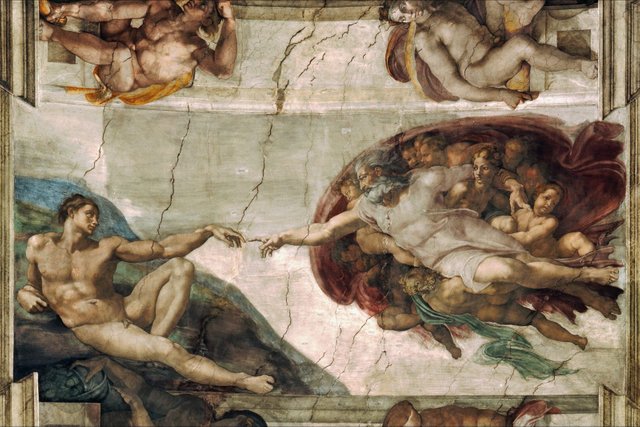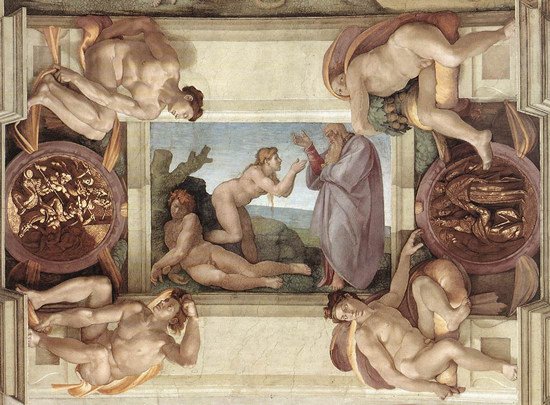Artwork Explained #15 : The Creation of Adam
The Creation of Adam is a detail on the fresco of the Sistine Chapel ceiling painted by Michelangelo between 1511 and 1512.
It represents the birth of Adam, according to the corresponding passage in the Book of Genesis. The fresco is considered a major work of the High Renaissance and was commissioned by Pope Julius II when Michelangelo was working on the tomb of the Pope.
This scene is one of the most famous among the frescoes of the Sistine Chapel ceiling by Michelangelo and is next to a similar piece, the Creation of Eve, as well as another major scene, the Separation of Waters and Earth.

Creation of Eve
The representation of Adam by Michelangelo is quite different from the other previous works of Creation. In this picture, God and Adam face each other, God floating in the sky, surrounded by angelic figures and a fluid mantle waved by the wind. Several people have noticed that the red mantle surrounding the celestial characters resembles a uterus and it is possible, considering Michelangelo's anatomical knowledge, that it is deliberate and symbolic of the concepts of creation and fertility.
In this picture, God appears as an old man, as a father figure with a big gray beard, but his body is vigorous and muscular, giving an impression of power. This representation of God with a tangible and powerful body, pushed forward in pure action, is very different from the usual images of God in Western art, as an immobile king, exercising his power from a throne. Instead of royal clothes, he wears a simple tunic revealing his arms and legs. In a sense, it makes God more human, more personal, less distant from humanity and more involved in events on Earth.
In contrast to the definite actions of God, Adam is stretched and stretches a casual arm towards God's index finger. This divine touch is meant to represent the divine spark of life that God gives to human beings. Both characters have similar characteristics in their postures as in the shape of their bodies, which would reflect the idea that God created man in his image.
Another subject of questioning in this fresco concerns the identity of the other characters that appear in the draperies surrounding God. Take, for example, this female figure who is directly under the left arm of God and looks to Adam. Generally, it is thought that Eve is present in spirit as she anticipates her own creation through the body of Adam, but others think it might be Mary, mother of Jesus, and that the child on his left, whom God holds by the shoulder, would be Jesus himself. If it turns out that this speculation is true, then this scene is highly symbolic and announces the coming of Christ who will deliver humanity from the original sin of Adam. It is also possible that this character is simply an angel with a particularly feminine aspect, without any particular meaning.
@siavach, Photographer and Art Lover
Wow excellent analysis :)
a very interesting article @ sivach, but the story of the origin of adam many variations, but the core story is almost the same, where the story that adam is the first man on earth. thank you has shared knowledge :)